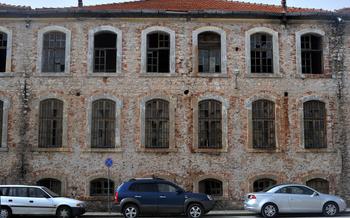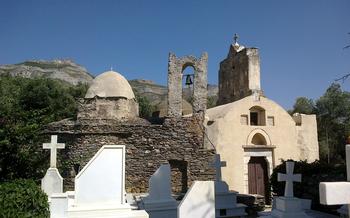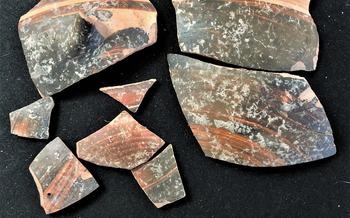
The Ecclesiastical Museum of the Holy Metropolis
- History of the Museum
- Location and Accessibility
- Museum Collection
- Religious Artifacts
- Manuscripts and Books
- Folk Art and Handicrafts: A Reflection of Local Traditions
- Temporary Exhibitions
- Guided Tours and Educational Programs: Delving Deeper into Komotini's Ecclesiastical Heritage
- Admission Fees and Hours of Operation
- Photography and Social Media: Share Your Experience
- Accessibility for Visitors with Disabilities
- Local Cuisine and Restaurants Nearby
- Combined Itineraries with Other Attractions
- Insider Tip:
History of the Museum
The Ecclesiastical Museum of the Holy Metropolis in Komotini is a treasure trove of religious and cultural artifacts that offers a glimpse into the rich history and heritage of the region. Established in 1975 under the initiative of the Holy Metropolis of Maroneia and Komotini, the museum is housed in a beautifully restored 19th-century building that once served as the residence of the Metropolitan. The museum's architecture seamlessly blends traditional and modern elements, creating a harmonious space for showcasing its diverse collection.
Location and Accessibility
The Ecclesiastical Museum of the Holy Metropolis is conveniently situated in the heart of Komotini, a vibrant city in northeastern Greece. It is housed within the premises of the Holy Metropolis of Maroneia and Komotini, a short walk from the city's central square, Plateia Eleftherias. The museum's exact address is 2 Vasilissis Olgas Street. To reach the museum, visitors can take a leisurely stroll from the city center or utilize public transportation. Komotini is well-connected by bus routes, and the museum is easily accessible from various parts of the city. Additionally, the museum is committed to inclusivity, providing wheelchair accessibility and ramps for visitors with disabilities.
Museum Collection
The Ecclesiastical Museum of the Holy Metropolis houses a diverse collection of artifacts and relics that narrate the rich religious and cultural history of the region. Among the notable highlights are exquisite icons dating back to the 16th century, adorned with intricate gold leaf and vibrant colors. These icons depict biblical scenes and saints, offering a glimpse into the artistic traditions and devotion of the past.
The museum also showcases an array of vestments, including beautifully embroidered priestly robes, as well as liturgical vessels such as chalices, patens, and crosses. These objects, crafted with meticulous care, were used in religious ceremonies and sacraments, symbolizing the sacredness and solemnity of the rituals.
The collection further includes a remarkable display of manuscripts and books, some dating back to the 12th century. These manuscripts, often adorned with intricate illuminations and calligraphy, provide valuable insights into the theological and historical knowledge of the time.
The museum's collection holds immense significance, not only from a religious standpoint but also in terms of its historical and cultural value. It serves as a testament to the enduring faith and traditions of the region, preserving the material legacy of a bygone era.
Religious Artifacts
At the heart of the Ecclesiastical Museum's collection lies an array of sacred objects that hold profound religious and cultural significance. Visitors are captivated by the resplendent icons, intricately embroidered vestments, and gleaming liturgical vessels that adorn the museum's displays.
The icons, with their vibrant colors and intricate gold leaf work, invite contemplation and inspire awe. Each icon depicts a different religious figure or scene, offering a glimpse into the rich tapestry of Christian history and iconography. The vestments, adorned with shimmering threads and delicate embellishments, symbolize the sacred nature of religious ceremonies.
The liturgical vessels, used in various rituals and ceremonies, stand as testaments to the deep faith and devotion of the local community. Chalices, patens, and incense burners, crafted with meticulous care, embody the essence of religious practices and traditions.
Beyond their aesthetic appeal, these religious artifacts serve as poignant reminders of the enduring power of faith and its ability to shape the cultural identity of a region. They offer a unique opportunity to delve into the spiritual heritage of Komotini and gain a deeper appreciation for the role religion has played in shaping its history and traditions.
Manuscripts and Books
The Ecclesiastical Museum of the Holy Metropolis boasts an impressive collection of rare and ancient manuscripts, including illuminated manuscripts that showcase exquisite artistry and craftsmanship. These manuscripts, dating back centuries, are a testament to the rich religious and cultural heritage of the region. Among the highlights is a beautifully preserved 12th-century Gospel book, adorned with intricate gold leaf and vibrant colors. Visitors can also marvel at a collection of historical books and documents that shed light on the history of the church and the local area. These manuscripts and books hold immense significance for scholars and researchers, providing valuable insights into the region's religious, historical, and cultural evolution.
Folk Art and Handicrafts: A Reflection of Local Traditions
The Ecclesiastical Museum of the Holy Metropolis in Komotini showcases a remarkable collection of folk art and handicrafts, offering a glimpse into the rich cultural heritage and artistic traditions of the region. Traditional costumes, intricate embroidery, and woven textiles adorn the museum's displays, showcasing the skill and creativity of local artisans. Handmade crafts and objects, such as pottery, woodwork, and metalwork, further represent the vibrant artistry and craftsmanship of the community. These items hold immense cultural significance, as they embody the continuity of local traditions and serve as a testament to the enduring spirit of the people of Komotini. Visitors are encouraged to admire the intricate details and vibrant colors of these artifacts, gaining a deeper appreciation for the cultural heritage that is so deeply intertwined with the identity of Komotini.
Temporary Exhibitions
The Ecclesiastical Museum of the Holy Metropolis of Komotini also hosts a variety of temporary exhibitions throughout the year, showcasing new acquisitions, specific themes, or collaborations with other institutions. These exhibitions offer a fresh perspective on the museum's collection and provide an opportunity to delve deeper into specific aspects of religious art, history, or culture.
Recent exhibitions have included displays of rare Byzantine icons, illuminated manuscripts from the Middle Ages, and contemporary ecclesiastical art. These exhibitions not only enhance the museum's offerings but also contribute to the ongoing dialogue and scholarship surrounding religious artifacts and their significance.
Visitors are encouraged to check the museum's website or social media pages for information on upcoming exhibitions. These temporary displays offer a dynamic and engaging way to experience the museum's collection and gain new insights into the rich religious and cultural heritage of Komotini.
Guided Tours and Educational Programs: Delving Deeper into Komotini's Ecclesiastical Heritage
The Ecclesiastical Museum of the Holy Metropolis offers guided tours for individuals and groups, providing an enriching experience that allows visitors to delve deeper into the significance and stories behind the artifacts. Knowledgeable guides lead these tours, sharing insights into the history, symbolism, and religious practices associated with the collection. Visitors can ask questions, engage in discussions, and gain a comprehensive understanding of the museum's treasures.
Additionally, the museum offers educational programs and workshops that cater to various age groups and interests. These programs aim to promote cultural awareness, foster creativity, and encourage hands-on learning. Participants can engage in activities such as Byzantine iconography workshops, traditional embroidery classes, or storytelling sessions inspired by the museum's collection. These programs provide an immersive and interactive way to connect with Komotini's ecclesiastical heritage and local traditions.
Admission Fees and Hours of Operation
Admission to the Ecclesiastical Museum of the Holy Metropolis is reasonably priced, making it accessible to visitors from all backgrounds. Regular admission fees apply, with concessions or discounts available for students, seniors, and families. It is advisable to check the official website or inquire at the museum for the most up-to-date information on fees and any special offers.
The museum follows specific hours of operation to ensure the preservation of its artifacts and provide a quality experience for visitors. It typically opens its doors from Tuesday to Sunday during the morning and afternoon hours. Please note that hours may vary depending on the season or public holidays. To avoid disappointment and plan your visit accordingly, it is recommended to check the museum's website or contact them directly for the exact hours of operation.
If you seek a more personalized experience, consider visiting during off-peak hours or on weekdays when there are fewer crowds. This will allow you toじっくりと explore the exhibits and engage with the museum staff, who are always ready to share their knowledge and insights.
Photography and Social Media: Share Your Experience
The Ecclesiastical Museum of the Holy Metropolis encourages visitors to capture and share their experiences through photography and social media. While preserving the sacredness of the exhibits, visitors are welcome to take photos for personal use. Sharing these images online can help spread awareness about the museum's unique collection and promote its cultural significance. However, it is important to be respectful of the artifacts and other visitors when taking photos. Using flash photography or tripods is not permitted as they can damage the delicate items on display. Remember to tag the museum and use relevant hashtags to connect with other enthusiasts and contribute to the museum's online community.
Instagram-worthy Spots:
-
Capture the intricate details of the Byzantine icons, showcasing their vibrant colors and exquisite craftsmanship.
-
Photograph the beautifully preserved vestments and liturgical vessels, highlighting their historical and religious importance.
-
Don't miss the opportunity to take a selfie in front of the museum's impressive facade, ensuring the grand architecture becomes a backdrop to your memorable visit.
Accessibility for Visitors with Disabilities
The Ecclesiastical Museum of the Holy Metropolis is committed to providing an inclusive and accessible environment for all visitors, regardless of their abilities or disabilities. Wheelchair users and visitors with limited mobility will find the museum easily navigable, thanks to the presence of ramps and elevators. These features ensure that every corner of the museum, including the exhibition halls and public areas, is accessible to all. Additionally, assistive devices such as wheelchairs and magnifying glasses are available upon request to enhance the visitor experience. The museum staff is trained to assist visitors with disabilities, ensuring a welcoming and enjoyable visit for everyone.
Local Cuisine and Restaurants Nearby
A visit to Komotini is not complete without savoring the delectable local cuisine. After immersing yourself in the rich history and culture at the Ecclesiastical Museum, take a culinary journey through the city's vibrant culinary scene.
For an authentic taste of Komotini, head to one of the traditional Greek tavernas or restaurants. Indulge in mouthwatering dishes such as souvlaki, gyros, and moussaka, prepared with fresh, local ingredients and grilled to perfection. Don't miss out on the dakos salad, a refreshing combination of barley rusks, tomatoes, feta cheese, and olive oil, a local specialty.
If you prefer a more contemporary dining experience, Komotini offers a variety of stylish restaurants serving innovative takes on Greek cuisine. Experiment with modern interpretations of classic dishes, often featuring local produce and seasonal ingredients.
For those with dietary restrictions, Komotini caters to various needs. Vegetarian and vegan options are becoming increasingly available, allowing you to enjoy delicious plant-based meals without compromising on flavor.
To enhance your culinary adventure, engage with the locals and ask for recommendations. They will gladly point you towards hidden gems and lesser-known eateries that offer a true taste of Komotini's culinary heritage. Embrace the opportunity to savor the authentic flavors and aromas that make Komotini's cuisine a delight for the senses.
Combined Itineraries with Other Attractions
Enrich your visit to the Ecclesiastical Museum of the Holy Metropolis by combining it with other captivating attractions in Komotini. Just a short stroll away, immerse yourself in the vibrant atmosphere of the Komotini Municipal Market. Experience the hustle and bustle as locals shop for fresh produce, aromatic spices, and delectable treats. Engage with friendly vendors and discover the culinary treasures of the region.
For a glimpse into the city's rich history, visit the Archaeological Museum of Komotini. This treasure trove houses artifacts from ancient civilizations that once flourished in the area. Marvel at exquisite pottery, intriguing sculptures, and intriguing inscriptions that narrate the captivating stories of Komotini's past.
Enhance your cultural immersion with a visit to the Folklore Museum of Komotini, showcasing the vibrant traditions and customs of the region. Admire intricate embroidery, traditional costumes, and handmade crafts that reflect the unique artistry of the local people. Learn about the customs and beliefs that have shaped the cultural identity of Komotini.
Combine your exploration of the city's heritage with a serene escape to the Municipal Park of Komotini. This tranquil oasis offers a welcome respite from the urban bustle. Stroll along shady paths, admire the colorful flowerbeds, and unwind by the tranquil lake. Embrace the opportunity to connect with nature and find moments of tranquility amidst the city's vibrant energy.
These combined itineraries provide a comprehensive and fulfilling experience, allowing you to delve into the cultural, historical, and natural treasures of Komotini. Create a tailor-made itinerary that suits your interests and time constraints, ensuring a memorable and enriching visit to this captivating city.
Insider Tip:
For an exclusive experience, inquire about the possibility of attending a special event or program organized by the Ecclesiastical Museum. Occasionally, the museum hosts lectures, workshops, or concerts centered around Byzantine and religious art, music, or history. These events offer a unique opportunity to delve deeper into the museum's collection, gain insights from experts, and engage with fellow enthusiasts. Keep an eye on the museum's website or social media channels for announcements regarding upcoming events.




